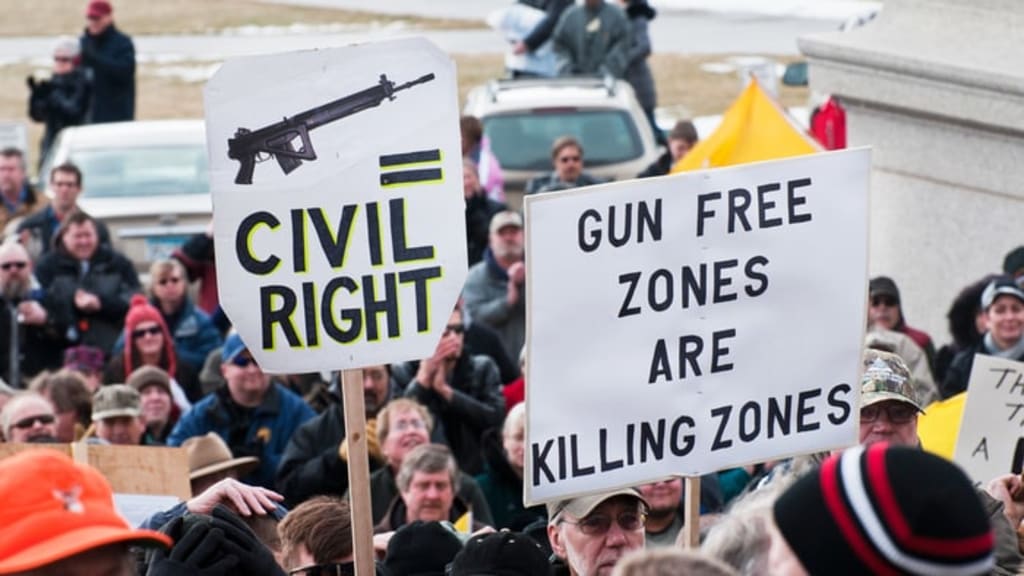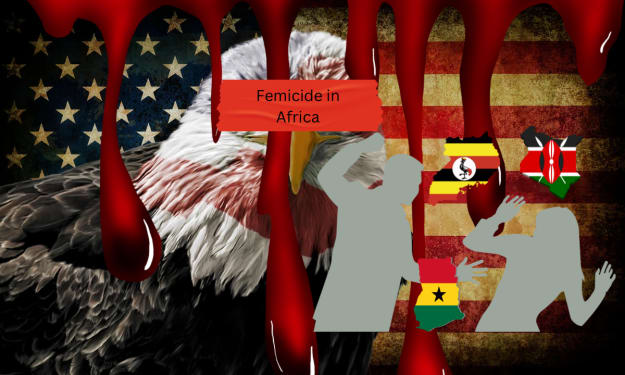Is Gun Control Really the Problem?
Extensive social media coverage may be the main reason school shootings are a frequent crime.

Students deserve the most nurturing care that American schools have to offer. Imagine accommodating these students’ needs by creating an atmosphere for children that is similar to the comfort they feel in their own home. Undying feelings of security would drive students to attend school with carefree attitudes ready to learn. Ideally, schools are a safe place for parents to send their children during the day. However, due to recent events of school shootings, these ideals seem to become a fantasy.
Within the past nineteen years, school shootings have devastated thousands of American families by being a popular copy-cat crime. As each tragedy takes place, families are broken from the loss of loved ones, while details of their suffering are broadcasted, opening the doorway to a nonstop massacre. The first mass school shooting affected Colorado. According to Lauren Thomas’, “Gun Control”, two Columbine High School students shot and killed thirteen other individuals before taking their own lives in 1999 (Thomas). Directly from the beginning, school shootings have been violent tragedies that will fail to cease. Years later, feeling secure in schools is no longer an option after an incident at a Connecticut elementary school. Thomas recalls in her article “Gun Control”, “a school shooting at Sandy Hook Elementary School in Newtown, Connecticut kills twenty children and six adults” (Thomas). Such young and innocent victims sent America into a rage which prompted them to immediately question the cause of such horrific events. To prevent school shootings from being a reappearing crime, explicit social media coverage should be limited to decrease opportunities of imitation, move away from normalizing this level of violence, and respect victims.
The highly controversial debate towards strengthening gun control laws is no secret due to the fact that Americans claim weak laws may be a cause of school shootings. Guns are made to be lethal weapons, and in the wrong hands have proved to create tragic outcomes; especially in America. Dennis Henigan points out in his article, “We Need to Strengthen Our Gun Laws”, “the U.S. is the only large industrial democracy reporting firearms as involved in a majority of its homicides” (Henigan). America is becoming infamous for gun-related crime, and skimpy gun control laws are an indefinite cause. No lives should be lost on school grounds; however, statistics shock the United States on a yearly basis due to easy access to firearm sales. In his same article, Henigan urgently demands “we need not tolerate the annual loss of 2,700 of our children and teens to gunfire” (Henigan). The severity of the crime is clearly put into perspective when the public truly realizes how many of America’s students are suffering the consequences. However, social media coverage may also be a platform leading to students’ worst nightmare.
Social media is by far the quickest method of sharing information with the largest audience possible. After the most recent school shootings, explicit footage taken by victims during the massacre was posted to social media. Being shared with millions of audience members, including future potential shooters, publicity becomes motivating for these criminals. It gives them the chance to see first-hand what it would be like to commit such a deadly crime. James Meindl claims in his article, “Mass Shootings”, “all information that could serve as a model for imitative behavior was provided via various media sources … and research has demonstrated that media can influence imitation” (Meindl). The violent outcomes are intriguing to those audience members who possess killer characteristics. Providing them access to on-scene footage may only encourage them more to mimic the shooting. Not only are potential school shooters driven by imitation, but they are also encouraged by mass amounts of publicity.
School shooters gain mass amounts of media attention directly after committing their crime. The nation is granted easy access to the shooters childhood, court appearances, and potential punishments. Everyone knows everything about them. For example, Nikolas Cruz is a very well-known name in America after participating in the Parkland, Florida school shooting. The entire nation has full-blown access to information about how he grew up, his mental state, and his time in court, due to an overwhelming number of interviews with his peers.

Some potential school shooters may find that appealing. James Meindl explains in his article, “Mass Shootings”, “this [extensive media] coverage often repeatedly presents the shooter’s image, manifesto, and life story and the details of the event, and doing so can directly influence imitation” (Meindl). Providing opportunities of fame and ideas for school shooters may also be a causative factor for the reoccurring tragedy that leaves families devastated.
Ideally, social media platforms such as Twitter and Snapchat, should limit the authenticity of school shooting coverage they broadcast. Live footage from any given school shooting should not be posted to the media. Explicit videos and images provide widespread audiences with reason to feel that they’ve been robbed of their innocence to the issue, as well as provide potential shooters with content that allows their imagination to run wild. James Meindl points out in “Mass Shootings”, “The way that the media report an event can play a role in increasing the probability of imitation” (Meindl). In situations where live footage is released, school shooters have benefitted. They gain knowledge of ideas and strategies that have been successful in the past and use it to their own advantage.
Taking into consideration a shooter’s weapon of choice, the AR-15 assault rifle seems to be a common thread in each school shooting. Aside from allowing shooters to see the authentic damage these weapons cause, gun violence on school campuses is at risk of being normalized through Twitter and Snapchat footage. After being seen on a day-to-day basis, statistics regarding the number of lives lost during the school day are to be expected. Dennis Henigan lists in his article, “We Need to Strengthen Gun Laws”, “12 killed, 58 wounded in the Aurora theatre shooting; 32 killed, 17 wounded at Virginia Tech; 13 killed, 32 wounded at Ft. Hood; 27 killed, 2 wounded at Sandy Hook Elementary School” (Henigan). Fatality lists are to be expected now due to extensive media coverage.
Limiting explicit social media coverage must be implemented in order to respect the victims who passed. There is a fine line between discretely writing condolences to post in remembrance of victims, and posting live footage of victims’ bodies. Considering the Parkland, Florida school shooting, live videos of the massacre were broadcast to social media platforms. Without any source of censorship, Twitter and Snapchat audiences were able to witness the vulgarity of what was equivalent to a war zone. Every ounce of dignity was stolen from passed victims the second videos of that nature were released to the public. Social media coverage not only enhances the potential for reoccurring shootings, but also disrespects victims.
Alternatively, a beneficial solution may be lengthening background checks to future gun buyers. While implementing strict background checks to obtain a firearm, room for complications still exist. Years ago, in order to keep gun sales strict, a policy was established before mass school shootings were even heard of. Therefore, the policy must have been effective. In Dennis Henigan’s, “We Need to Strengthen Our Gun Laws”, the Brady Handgun Violence Prevention Act is described. He explains that the act, established in 1994, does not allow the sale of firearms to those who seem unable to handle the responsibility of owning a gun. Henigan points out that background checks are issued to determine the reliability of the potential gun buyer. For example, Henigan says the policy screens for convicted felons, domestic violence misdemeanors, restraining orders, and mental illnesses. He claims that two million firearm sales were prohibited due to the Brady Act (Henigan). Giving the public false hope, the Brady Act eventually failed to keep firearms away from unfit owners leading to a tragic school shooting at Virginia Tech. The screenings proved to be an inadequate test of character, and ultimately provided a violent individual with the weapon he needed. Henigan explains “The shooter was already a prohibited gun buyer because, in 2005, he had been found by a Virginia judge to be mentally ill” (Henigan). Something as complicated as changing the law is much easier said than done. Loopholes will continuously be found, and mistakes will undoubtedly be made.
Another potential solution could be to strengthen America’s gun laws. However, a solution based off of feelings has a slim chance of being effective. On one end of the spectrum, there are groups of citizens determined to protect their Second Amendment rights, which declares citizens the right to bear arms. Greg Lee Carter points out in his article, “Ironies”, “strong gun rights advocates don’t really care that those states with the most restrictive gun laws tend to have fewer gun violence deaths than those states with weaker gun laws” (Carter). Passing such a complicated law is much easier said than done with two extremist groups on either side without a steady agreement. Lawrence Southwick, a professor from Carnegie Mellon University, explains the misunderstanding in his article, “The United States Doesn’t Need More Gun Laws”. He puts into perspective the ineffective nature of strengthening laws by numerous comparisons. For example, Southwick explains that illegal drug sales do not have the slightest effect on what goes on behind closed doors. He claims that the strict laws only enhance drug sales, so a stricter set of gun laws would not have any different outcome (Southwick). A law based upon wishful thinking may not have the desired effect that America needs.
Based on extensive research, limiting the amount of explicit social media coverage may be the only way to deter potential shooters from targeting the next school. Not only will it respect those victimized by attack and end the normalization of such horrific violence, but will inhibit potential shooters from gaining access to tactics they can mimic. One individual may not be able to boycott vulgar footage that is shared with an audience of millions; however, the nation should make it their responsibility to stop feeding potential shooters with the ideas and motives that may take their students’ or own children’s lives.






Comments
There are no comments for this story
Be the first to respond and start the conversation.